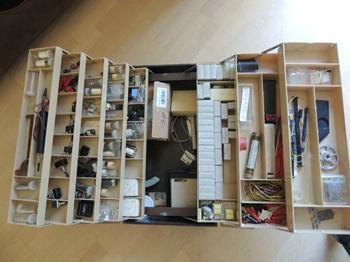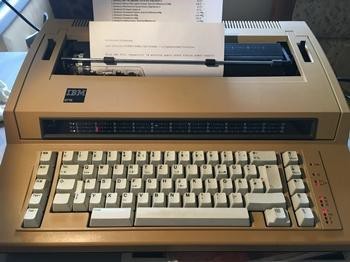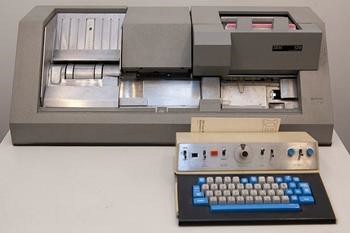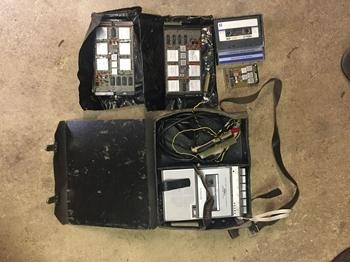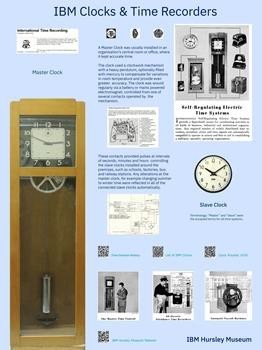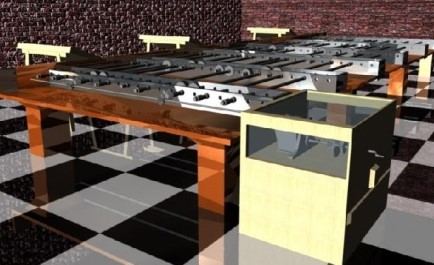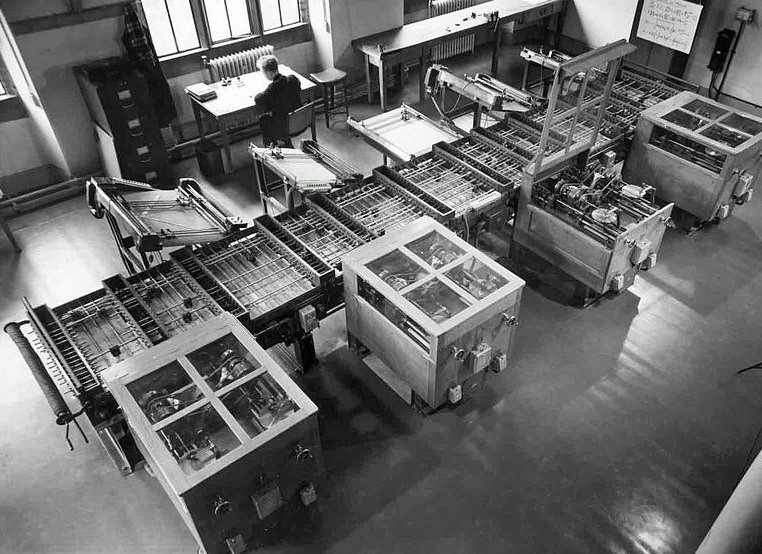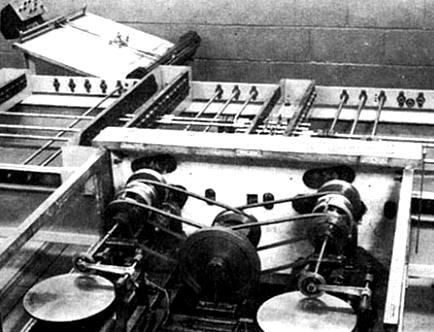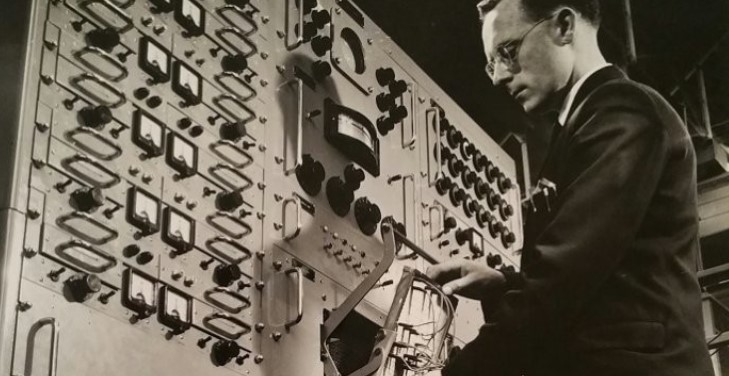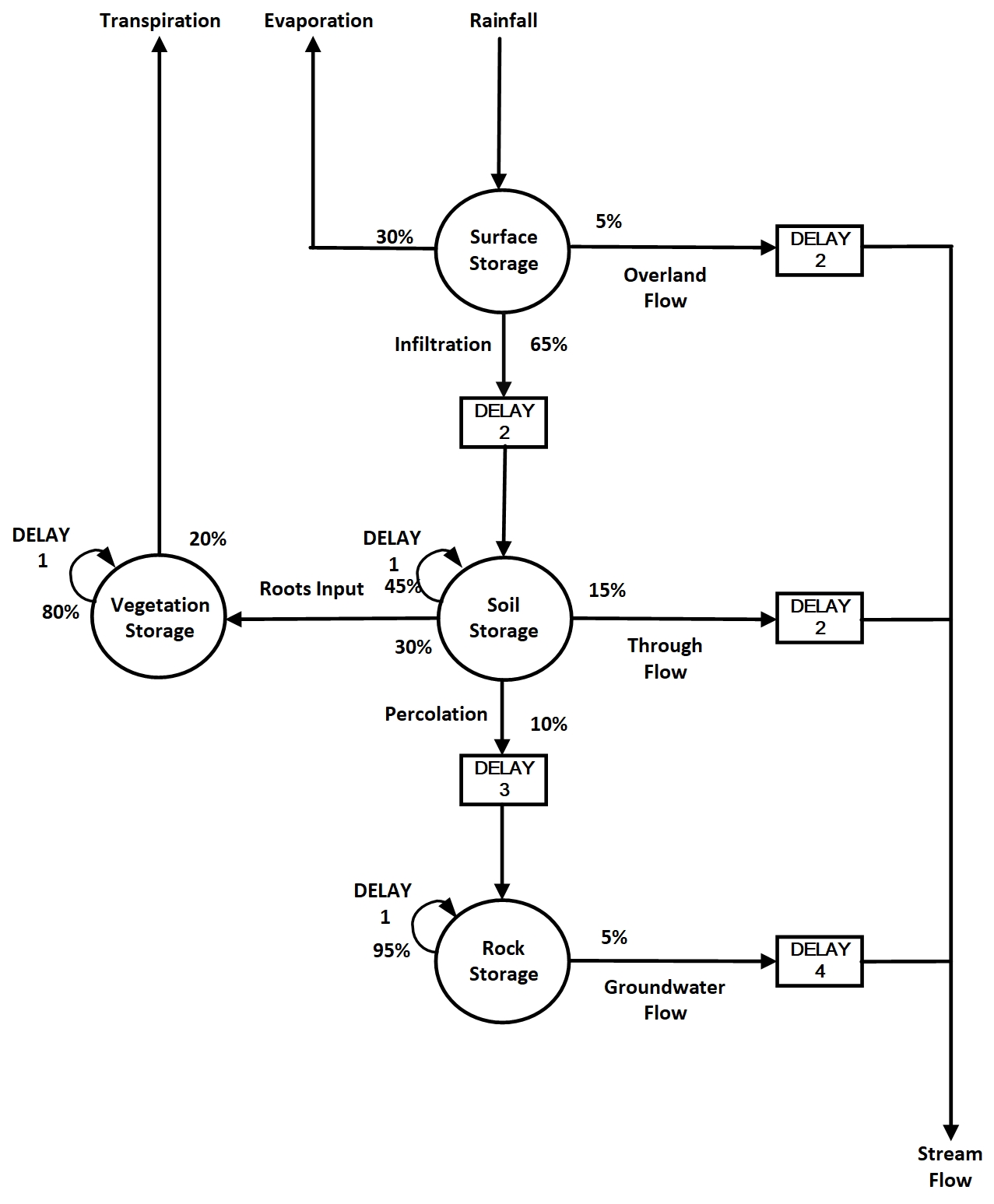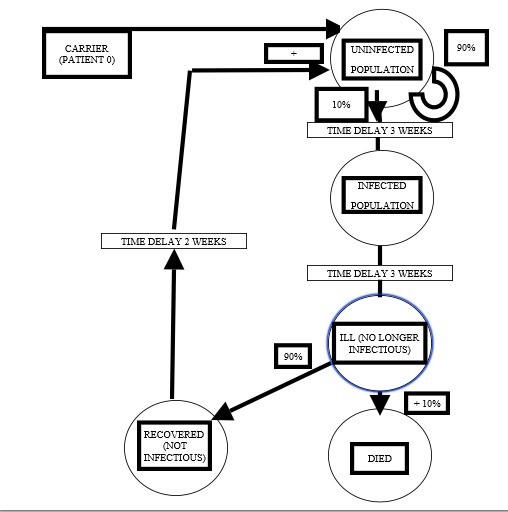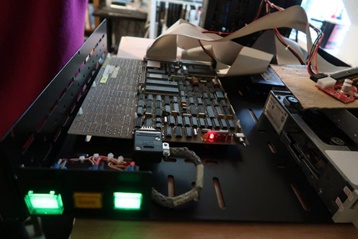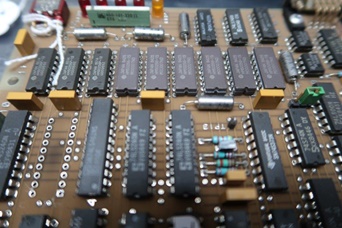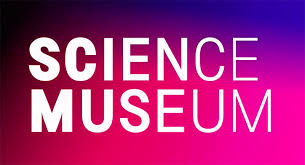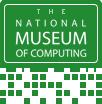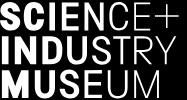| Resurrection Home | Previous issue | Next issue | View Original Cover | PDF Version |
Computer
RESURRECTION
The Journal of the Computer Conservation Society
ISSN 0958-7403
|
Number 91 |
Autumn 2020 |
Contents
Society Activity
|
Readers will, we feel sure, understand that the Society has been relatively inactive for the last few months. Coronavirus restrictions on museums and other premises have meant that much of our work has had to be halted or drastically scaled back. Nonetheless some projects where work has been undertaken “offline” have progressed... |
|
IBM Museum — Peter Short Current Activities This has not meant that work has dried up; indeed there have been a lot more activities from home. We have had quite a few donations delivered to home addresses and subsequently dropped off at Hursley with a ‘permitted’ member of staff taking them inside. That has also allowed us to retrieve items so we can carry on with off-site activities. We’ve also introduced curator Zoom meetings every couple of weeks. Here are some of the highlights since May:
|
|
Analytical Engine — Doron Swade Archival and source retrieval work has continued. Specifically, reconnecting with the widow of the late Allan Bromley whose seminal work on the Analytical Engine remains the authoritative study of the Engine designs. Some of Bromley’s papers were deposited at the Powerhouse Museum, Sydney, Australia. The rest are in the private possession of Allan’s widow. Attempts are being made to establish the scope and content of this material specifically with respect to identifying references found for which we have no sources. The work is being carried out by Tim Robinson in the US. Progress has been intermitted since Tim was evacuated from his home because of the rampant fires in California which reached his yard. A Zoom project review meeting is being scheduled between the three project activists, one in Portugal, one in California and one in London. |
|
ICL2966 — Delwyn Holroyd The machine has been run up a few times whilst the museum has been closed to the public with no significant problems apart from a recurrence of the intermittent power supply issue which has plagued one of the 7181 terminals for some years. Following an unfortunate incident during fault-finding I have now replaced the IC which provides the reference voltage to the 5V switch mode supply. Hopefully this has cured the problem but only time will tell. |
|
Elliott 803 & 920M — Terry Froggatt In the previous issue of Resurrection, I reported that the Elliott 920M, purchased via eBay last year, was almost working. I’m pleased to report now that it is fully operational. (There were two problems with my breadboard rig and two faults in the 920M). And I’m equally pleased to report that we have now established that the 920M on loan from the Rochester Avionic Archives (RAA) to TNMoC is also fully operational. On my breadboard rig, firstly, there was a voltage drop problem. The 920M needs about 5 amps at +5.5 volts (and below 1 amp at -5.5 volts) for its logic, which I was taking from my own 903’s 6 volt power supplies, necessarily a few feet away. I found that I was not getting the full +5.5 volts at the 920M, unless I set the 903 to over 6 volts, putting the 903 at risk, and putting the 920M at risk during power-up. I cured this by beefing up the +5.5 volt and ground return cables. Secondly, the Windows 95 operating system on the IBM ThinkPad (which I was using to simulate a paper-tape station) was also servicing interrupts, occasionally causing the ThinkPad’s “Acknowledge” pulse to the 920M to be stretched. The 920M looks for a level rather than an edge, so it was transmitting further characters during the stretched pulse, which the ThinkPad missed. This was cured using a TTL 74123 monostable, so that only a 5 µsec pulse was generated. I also modified my rig to be able to catch all eight bits of the 920M paper-tape punch output, even though the ThinkPad printer port only has five input bits, by using a TTL 74151 data selector. On the eBay 920M itself, as previously reported, there was a store fault: ⅛th of the store was zero (specifically the words 64 to 127 of every 512 words). Erik Baigar kindly mailed me two untested 47F store address driver & gate modules (from the 920M which he is now using for spares). After a little practice with a wire-wrap tool, I managed to neatly replace the faulty 47F, which cured this fault. Unfortunately by this point, a second fault had been found in 1/64th of the store (at word 23 of every 64 words), which was clearly associated with a specific core address wire (rather than a driver or gate). I located a faulty diode pair at one end of the wire, but rather than attempt to replace the eight diode flat-packs, slightly less neatly I fitted a “new old” pair of discrete diodes. I was only able to locate both faults because of the effort Erik and I had put in, earlier in the year, to trace the store wiring: we still have no official circuit diagrams. Turning now to the RAA/TNMoC 920M, once it was clear that my breadboard power supply was up to the job, and having agreed that he and I had been equally Covid-cautious, Andrew Herbert brought this 920M to me, with the failure-prone capacitors disconnected. We went through a sequence of tests which I’d developed, starting with very brief power applications, and then running a store test which preserved store contents. Next we dumped out the existing core store contents, before testing the store addressing and the full instruction set. Finally we ran the usual applications like BASIC and the CountDown program. Everything worked perfectly. As with the eBay 920M, the RAA 920M was found to contain an issue of the Jaguar Flight Program, but whereas the eBay 920M was last used at Thumrait airfield in Oman, the RAA 920M was last used at Warton airfield, with other waypoints at Farnborough & Boscombe Down. A few dozen words of the program were found to be corrupt, which could be why the machine was taken out of service. But at least one repair wire is visible, and these words of store are certainly working now. Erik has made us a power supply for this 920M, and Andrew plans to build a Raspberry Pi simulated paper tape station for it in due course. Meanwhile I plan to build a tidier power supply for the eBay 920M. |
|
Software — David Holdsworth LEO III Two ex-Leo people, Ray Smith and Ken Kemp, have assembled a kit of parts for running your own Intercode on your own Windows computer. Its availability was circulated around the Leo Society inviting Intercode ex-programmers to email Ray requesting the package. Here is Ray’s analysis:
KDF9 David Huxtable and I are working towards a "canonical" implementation of Kidsgrove Algol, in the hope of being very close to the production version, while working round the missing components and a couple of bugs that we believe were not in the production version. This has motivated him to investigate various aspects of the compiler. The current state of play can be executed at http://37.122.196.165/KDF9/langs.htm. This is all very much a loose end, and there are broken links to the listings of the original source, and elsewhere. By way of recap, it may be worth saying that the surviving listing of this courageous overlaid optimising Algol60 compiler lacked one of the overlays and most of the underlying support system. We also now have reason to believe that it was not the final released version. A nearly complete listing of the run-time library turned up from a different course largely by chance. We also have scans of lots of English Electric paperwork, both published manuals and internal documents. There was more than enough to excite interest, and it has been fascinating getting it to work. Like any work of art, the difficult part is knowing when to stop. The aim is to improve on the structure that can be seen on the “old” server at: sw.ccs.bcs.org/KDF9/langs.htm. Atlas I Progress, which has been embarrassingly imperceptible these several years past, has been rapid and has resulted in a new release of the emulator and its various software artefacts – the first since 2014. The new release adds support for job descriptions, disc files and numerous other small enhancements – too many to recount here, even if one could bring them all to mind. Atlas system software was based around a “Supervisor Tape” which contained a selection of compilers for the various programming languages. Some of these were not compilers at all but other utility programs. COMPILER SPECIAL was a utility whose task was to initiate software held in supervisor tape format but held on other tapes. This has been duly replicated from scratch and eases the task of testing further compilers. COMPILER SERVICE was a series of utility programs which could be called upon by name in sequence mainly for manipulating various media files. A paper listing of the source code has recently been discovered by Bill Williams and will, in due course, be transcribed into machine-readable form and tested. Meanwhile, however, an inauthentic program in the same spirit as COMPILER SERVICE has been developed using a mix of the Brooker-Morris Compiler Compiler and the standard Atlas Assembler (ABL) aimed at manipulating magnetic tapes and especially tapes in Supervisor format. COMPILER MAGUTILS accepts a series of commands to manipulate tape and disc files, compiles them and then carries out the instructions. |
|
ICT/ICL 1900 — Delwyn Holroyd
The FDS emulation has been updated and the 2806 is now working with E6RM and GEORGE 3 version 8.64. In addition the other FDS models (2804 and 2805) have been added. Under GEORGE 3, the FDS can be used for filestore residences and for exofiles. There is still a limitation that one cannot have more than a single transport connected to a controller and have them work properly. Both E6RM and EWG3, according to the manual, can be configured to support up to eight transports per controller. This limitation may not be resolved, depending on how much more effort is required. We don’t regard it as a major problem as very few of these drives were delivered and none of those sites had more than a single transport installed, to the best of our knowledge. To give an idea of the testing time involved, it takes a couple of hours to create and initialise an indexed data file a quarter the size of the drive capacity and a further five hours to load a substantial set of data. For testing I was using four files – that is over 24 hours elapsed time just to set up a test. Note that the emulator and peripherals are timed to match the original hardware speeds as near as practical. In the process of finding out why the FDS wasn’t working correctly under GEORGE 3, we discovered that the FDS code was likely fossilised by the time of mark 8.64 and that subsequent marks started to actively remove FDS specific code from parts of GEORGE. A side effect of the search through tapes brought to light that a copy of the binary distribution of GEORGE 3 Mk 8.64 has survived; the ‘system’ and ‘addsys’ tapes, but unfortunately not (so far) the partial source tapes – two tapes from a set of four. |
|
Harwell Dekatron/WITCH — Delwyn Holroyd The machine has been kept ticking over regularly during the period when the museum was closed and has been running well since it re-opened earlier this month. |
|
Bletchley Park Trust — Peronel Craddock Bletchley park reopened to visitors on 4th July, with new operational measures in place to ensure a safe and welcoming experience. We also opened Never Alone, a new temporary exhibition in Hut 12 that investigates the rapidly expanding Internet of Things. We have continued to focus on creating new digital content over the summer for those not able to visit in person, on our website, social media, YouTube channel, and the Bletchley Park podcast. We were delighted to be awarded the Must Visit award and Judges’ Discretionary Award of Best in Heritage at the UK Heritage Awards 2020. We are also shortlisted for Shop of the Year in the Museum & Heritage Awards. Bletchley Park is currently in a period of consultation around a proposed organisational restructure, due to the financial impact of the coronavirus pandemic. |
IEEE Annals of the History of ComputingConcessionary Rates for CCS MembersBy arrangement with the publishers, members of the CCS are eligible for substantially reduced subscription rates. An annual subscription currently costs £55.00 for four print-copy issues including postage within the UK. If you are interested taking advantage of this arrangement please let Doron Swade know by emailing him at: doron.swade@blueyonder.co.uk. The first issue for new subscribers will be available January 2020. Expressing interest at this stage is not a commitment to subscribe. Registering an interest now simply allows me to send you further details closer to renewal time. IEEE Annals of the History of Computing is the pre-eminent archival journal for the history of computing. Launched in 1979 it is a peer-reviewed quarterly publication featuring articles by computer experts, historians, and practitioners, and includes unique first-hand accounts by computer pioneers. |
News Round-Up
|
Regular readers will perhaps recall a series entitled My Life in Computing, in which CCS members recalled highlights from their interesting and varied computing careers. David Pentecost has gone one better and has written up the story of his career at length. The sheer variety of rôles which he has undertaken cannot fail to impress. From using DEUCE at the NPL in 1959 to specialising in IT services to the legal profession in the 1990s and latterly as a contributor to the CCS Our Computer Heritage project. Go to www.computerconservationsociety.org/rd/pentecost.pdf and enjoy! 101010101 Exciting news reaches us from the London Science Museum which is embarking on a new computer history project in collaboration with several other museums, not least the National Museum of Computing. More in the next edition with luck. 101010101 Ever industrious, our friend Herbert Bruderer has turned up an operating manual for the Zuse Z4 relay-based machine of 1945. Go to www.computerconservationsociety.org/rd/z4man.htm for the article. 101010101 We have belatedly become aware of the sad death of David Yates author of Turing’s-Legacy: A History of Computing at the NPL. . He died in 2019. |
Contact details
Readers wishing to contact the Editor may do so by email to
Members who move house or change email address should go to
Queries about all other CCS matters should be addressed to the Secretary, Rachel Burnett atrb@burnett.uk.net, or by post to 80 Broom Park, Teddington, TW11 9RR. |
Repairing an Argus 700 MS221 Tape Controller
Peter Harry
A short case study describing the repair of an Argus 700 tape controller. It illustrates the challenges faced with computer restoration where you lack original test sets and documentation but are fortunate to have original logic diagrams. MS221 Overview The MS221 is a steaming tape controller with QIC-02 (tape) and SCSI-2 (disk) interfaces. Designed using 74 series TTL (Transistor-Transistor Logic) devices and a Z80B processor. The MS221:
MS221 Fault Indication
Following a system initialise the MS221 can give a visual indication of a fault on the unit. The LED indicators on the MS221 board and the tape load and dump push buttons remain lit when they shouldn’t be. The accompanying photo illustrates such a fault condition. A serviceable MS221 completes its self-check to leave a single LED flashing, a heartbeat indication. MS221 Components The discrete TTL components of the MS221 have one big advantage when it comes to repairs, you can get spares. I also have a copy of the original logic diagrams and a circuit diagram, for the MS221 without which finding a fault would be almost impossible. A common design practice on the Argus 700 was to create intelligent peripheral controllers of which the MS221 is a good example. I do not have a block diagram for the MS221 to better explain the units design, even if one exists. Such a diagram would show a Z80B eight-bit processor, 256Kb of DRAM (Dynamic Random Access Memory) with parity, a 2764 EPROM (Erasable Programmable Read-only Memory) and peripheral interfaces for the SCSI-2 and QIC-02 bus. A Common MS221 Failure On initialisation the MS221 runs self-checks which include DRAM testing. While the DRAM is test is running two of the five on-board LEDs will light in sequence. The self-test exercises one bank of 128Kb and then the second bank of 128Kb. A failure of a DRAM chip, detected by the self-test, results in a parity error which interrupts (halts) the Z80B and a LED on the board will remain lit. It doesn’t tell you which DRAM is faulty. The DRAM fault problem is considered later. Fault Finding the MS221 Anyone who fault-finds a microprocessor system will be familiar with the difficulty of tracing faults in a closed loop system where a fault could be any device in the loop – but which device? When a fault occurs with any PCB the first step is to look for the obvious. Make a visual inspection of the PCB for heat damage and use a magnifying glass to check soldered devices for possible dry joints. When a TTL device fails it will often become very hot, sometimes enough to discolour a PCB. After switching on gently touch, with the ball of your hand, the tops of all TTL devices to identify any that are exceptionally hot. Always wear an earthed anti-static wrist strap when doing this. If nothing obvious is discovered with the physical checks then it’s time to get the voltmeter and oscilloscope out and check for a TTL device failure. With power on the MS221 (+5 Volts from a bench power supply) the first thing to check is activity on the Z80B’s data and address lines with the oscilloscope as memory testing takes place. This involves re-initiating the MS221 as a memory parity failure stops the self-test. If the address and data lines have activity on them the next check is on the logic that controls the DRAM devices, the timing pulses and data in and out on the MS221’s nine DRAM devices. After eliminating the obvious and if the memory self-test is still failing then all the indications point to a faulty DRAM device, possibly a fault with one of the 250,000 memory cells on one of the devices. Finding such a fault is not easy.
Using the above techniques on a faulty MS221 it identified a failed TTL device. Checking the data lines from the Z80B revealed no activity on one of the eight data lines to the DRAM devices, line 0 (D0) was permanently stuck on logic level 0 with no activity, i.e. no 1s at any time. The fault was found to be a 74S240 device with pin 18 short to 0 volts. The device was replaced and the MS221 is now working correctly once more. The above photo of the MS221 shows where the 74S240 was removed. Note the discolouration on the PCB possibly indicating that the device had become very hot at some time. Finding a DRAM Fault? The fault described above was due to a TTL device which had an obvious short on a pin. I have a second MS221 that fails the memory self-test, but this time there is no obvious TTL failure so it points to a faulty DRAM device. A lot of computers of this generation (1980s) had their memory devices socketed so it was easy to replace each DRAM device in turn until the faulty DRAM was found. Unfortunately, the MS221 has its nine DRAM devices soldered in the PCB. There is no easy solution as unsoldering all nine devices and replacing them risks damaging the PCB. I have seen one MS221 with five out of the nine devices replaced. It looks like whoever repaired the unit previously started replacing the DRAM devices from one end and then worked through until the fault disappeared! What to do in the case of a DRAM failure? Without the original test equipment or specifications there is little choice other than to start replacing devices and risk damaging the PCB. There is a test socket on the MS221 on which I have no information, can this be used to identify a defective DRAM? Is creating my own test set an option? As I have repaired one MS221 the pressure to have a spare is reduced so it’s time to consider my options further before deciding. |
A visit to Museo de Infomática, Buenos Aires
Peta Walmisley|
The museum was founded 10 years ago as a result of Carlos Chiodini's collecting habits. He had amassed about 6000 items of computer equipment, among other things, when his wife, Alicia Murchio, suggested they would be more useful as a collection open to the public. They moved to their present site three years ago and have a collection now of about 85,000 items. Of course most of these are stored in the basement, but they turn them over monthly, as well as having specific exhibitions. Once a year, as part of a Buenos Aires-wide ‘Night of the Museums’, they are open from 8pm to 2am on the specified Saturday night and normally have well over a thousand visitors. The pride of place is held by a real size mockup of a Ferranti Mercury, which was the subject of the submission to the Tony Sale Award. The original computer, nicknamed Clementina, came to the Calculus Department of the University of Buenos Aires, as the first scientific computer in Argentina, in 1961. The accumulated experience at the department was lost due to the military intervention of the university in 1966 causing the exile of nearly all the scientists. The actual hardware, already obsolete, was finally broken up and dumped unceremoniously in 1971 with nearly everything lost. Clementina’s mockup was built by volunteers under the supervision of Javier Albinarrate, a software engineer and entrepreneur. The great help given by CCS’s Simon Lavington should be noted. He put them in touch with the National Museums Scotland (NMS) in Edinburgh, where a surviving Mercury has been in store since 1970, and from where they were able to obtain photographs and measurements which allowed them to make a detailed physical mockup. The main goal of the project is give a real impression to visitors of what programming was like back in the 1950s and 60s by simulating the control panel and all the I/O interfaces with modern microcontrollers and connecting punched paper tape peripherals of the era along with mechanical teleprinters, all connected to a computer that can orchestrate the whole thing. Presently there is ongoing work to produce a timing-accurate emulator of the Mercury to run real programs. Javier is calling on anyone in the UK who has a spare Creed teleprinter available, as it was originally used by Ferranti (Model 6 tape reader, Model 25 tape puncher and Model 75 teleprinter), which is unavailable in Argentina. Today, the exhibition relies entirely on Siemens equipment! |
50 Years ago .... From the Pages of Computer WeeklyBrian AldousCost-cutting TTL memory from Tl: A new TTL random access memory monolithic integrated circuit, the SN54/74170, which is claimed to improve memory utilisation by 100% over conventional bipolar random-access memories, has been announced by Texas Instruments of Bedford. It is expected to be particularly suitable for scratch pad and high-speed buffer memory applications. (CW 3/9/70 p16) Myriad III meets needs of air traffic control: Claimed to be the most flexible on-line computer ever produced, the Marconi Myriad III was unveiled this week at the Farnborough Air Show. Designed specifically to meet the stringent demands of advanced air traffic control and defence radar processing systems, the Myriad III will be marketed by Marconi-Elliott Computer Systems Ltd, but its development was financed by Marconi Radar Systems Ltd, which is expected to be the principal user. (CW 10/9/70 p1) Remote meter reading system developed: The disappearance of the “gas man” may be one of a number of far-reaching effects that will stem from the announcement of an automatic remote meter reading and load control system by the Plessey Electronics Group. The new system, which is suitable for electricity and water as well as gas, will enable supply boards to invoice customers automatically. The Plessey system, which has been developed by them in co-operation with the London Electricity Board and the South-Eastern Gas Board, enables meters fitted with a simple reed switch to be read electronically every half minute by a scanner. Each scanner, which is connected to meters by ordinary telephone or private pilot lines, can deal with up to 1,000 meters in groups of up to 100. (CW 10/9/70 p3) Sigma 5s to aid Jupiter flights: Two US Pioneer spacecraft, due to make 500 million-mile flights to Jupiter in February 1972 and 1973, are to be monitored through ten months of pre-flight testing by two XDS Sigma 5 computers which are in the process of being installed at Redondo Beach, California by NASA. On the two-year trip to Jupiter each spacecraft will carry a number of scientific experimental packages which will analyse the earth’s atmosphere, measure magnetic fields, solar winds, cosmic radiation and the nature and intensity of a meteoroid belt which separates earth from the outer planets. As these packages are assembled they will be tested under laboratory-simulated, inflight conditions. Data from all the instruments will be collected and encoded into a single telemetry signal by communications equipment on board the craft, and then transmitted to a test station in the spacecraft assembly area, where the two computers will process the data and report malfunctions. (CW 24/9/70 p21) Tories urged ‘Protect the Privacy of Individuals’: Among resolutions submitted by local Tory branches for possible discussion at next week’s Conservative Party conference at Blackpool is one drawing attention to “the dangers to individual freedom entailed in the development of sophisticated technological aids such as databanks, and particularly their us by administrative agencies”. The resolution, from the West Ham constituency, urges the government to adopt legislative and other measures to “protect the privacy of the individual from undue interference”. Another motion, from Southgate, views with concern “the increasing number of state, commercial and private organisations which hold personal information on individuals, and which communicate this information to other bodies”. It says legislation is needed to protect personal liberty. (CW 1/10/70 p63) Data General backs Europe bid with new machines: A strong challenge in the minicomputer market is being made by Data General Corp, of Massachusetts, manufacturer of the Nova and Supernova machines, with the introduction of three new fast machines, one of them featuring a semiconductor main memory. These coincide with an increased sales drive in Europe. The 16-bit word machines, all of which can have up to 32K of memory, are hardware and software compatible with the existing Nova and Supernova machines which they will supersede. The new Nova 1200 has a core cycle time of 1,200 nanoseconds, and will be available next March. The Nova 800, which has a cycle time of 800 nanoseconds, is scheduled for next April. The Supernova SC, an all semiconductor machine with an MOS memory which has a cycle time of 300 nanoseconds, will be available next June. The new machines will be entering a now fiercely competitive market in which the Digital Equipment Corp is the foremost manufacturer worldwide. In terms of 16-bit machines the DEC PDP-11 range, for which an extended arithmetic element was recently announced, will probably provide the main competition. (CW 8/10/70 p24) Plated wire is here to stay: Plated wire memories are about to take off, according to Mr N. Crocker, divisional director of the memories and materials division of Plessey Components Group, which is now marketing what is claimed as the first plated wire memory commercially available anywhere in the world. Plessey, which delivered the Mark I S250 plated wire memory to Mintech last year, was showing the Mark II at the Computer 70 exhibition, and Mr Crocker, at a seminar on Plessey memories held at the Kensington Palace Hotel last week, said there was a great deal of interest now , particularly in the US where Plessey showed a fast plated wire memory at the Sprint Joint Conference. (CW 15/10/70 p9) IBM 1130 helps study pollution effects on fish: Researchers at the Great Lakes Fishery Laboratory at Ann Arbor, Michigan are using an IBM 1130 computer to help study changes in the fish population of the lakes. The laboratory is particularly concerned with the effect of pollution in the Great Lakes. Four research vessels on the lakes record data on fish population by geographical area and type, as well as noting biological, chemical and physical changes taking place in the water. This data is combined with “catch” information and historical records provided by commercial fishermen and state agencies for computer processing. The computer correlates the data into charts for conservationists. (CW 22/10/70 p11) 4/70s bring changes for UK Atomic Energy: The installation of three ICL 4/70 computers marks the year 1969/70 for the UK Atomic Energy Authority as one of change in several of their centres. The UKAEA’s report for the year, published last week, states that the System 4/70 installed at Risley in Lancashire now has data links to the establishments at Capenhurst, Dounreay, Springfields and Windscale, but also says that software difficulties at first hindered the transfer of commercial and managerial work on this machine. Software difficulties are not referred to in connection with the 4/70s at Culham and Winfrith, both of which will take over the work of KDF9s, but software developed for the KDF9, including the Cotan multi-access system, has reached such a high standard that the authority’s personnel and ICL will have to work hard to get System 4 software up to the same standard before the handover of work from the old to the new machines is finally completed. (CW 22/10/70 p26) Alpha 3 unveiled by Air France: “Do-it-Yourself” systems which will enable an airline passenger to make a seat reservation, pay for it by credit card and collect a ticket, baggage tags and boarding pass from automatic printers, were envisaged by Mr George H. Geick, executive vice-president of Univac, when he unveiled Air France’s Alpha 3 reservations system in Paris last week. Univac was now working with the airlines in the development of Automated Passenger Processing Systems and these would become a familiar feature of the world’s larger airports within the next five years, said Mr Geick. Such systems would automate the passenger handling functions of the airport enabling credit cards to be verified, tickets and other documents to be printed and passengers to be admitted to the aircraft, without human intervention. Although such applications were unlikely to materialise before the mid-Seventies Mr Geick was justifiably pleased with his company’s record in meeting the more conventional computing requirements of the world’s airlines. Univac, he claimed, was already supplying 15 airlines including two-thirds of the major trunk carriers with equipment valued at $132 million. This included 84 Univac central processors to which nearly 7,000 remote terminals were currently connected. (CW 29/10/70 p10) Practical Optical Fibre for Wide Band Communications: Practical optical fibre wide-band telecommunication systems are likely to be produced within five years, according to Standard Telecommunication Laboratories of Harlow. The company, which is working in conjunction with two US firms, the Corning Glass Co and Bell Laboratories, has recently succeeded in fabricating an optical waveguide fibre with suitable characteristics. It has also successfully coated the hair-thin fibres with plastic to form a wire-like element which can be assembled into a complete cable. The cable is flexible and could be installed in existing cable ducts. (CW 29/10/70 p11) 1904A will aid UK space research: The Radio and Space Research Station at Datchet, Buckinghamshire, has installed an ICL 1904A computer to replace the 1905 machine which the station, a Science Research Council establishment, has been using for the last two years. One of the main reasons for this expansion is the greater demand placed on the station’s computing resources by the forthcoming launch of the UK4 research satellite. The new processor has a 64K word core store and floating-point unit. The existing 1905 peripherals will remain in use, augmented by six additional standard interfaces and two additional exchangeable disc units, giving a total value to the installation of nearly £400,000. The new equipment is worth £246,000. The RSRS is mainly involved in tropospheric and ionospheric research, including the use of these regions in communications. It works closely with NASA and ESRO, for which it is currently processing some experimental data, and has two satellite-tracking and data acquisition out-stations – one at Winkfield in Berkshire, and one in the Falkland Islands. (CW 5/11/70 p1) Second Hermes for air traffic control: Experience with Ferranti’s computer-based flight plan processing system, Minicap, which it has used operationally since about 1967, has prompted the West Drayton Air Traffic Control Centre to order a second Hermes computer and other hardware from Ferranti. Besides a second central processor a 32K store has been ordered for the first Hermes computer, and the 8K of store from this machine will be transferred to the second one, giving it a 12K capacity. Other hardware ordered also includes control logic for five more flight progress strip printers. (CW 12/11/70 p28) BCL adds Mini-Susie to its range of VRCs: Following the success of the present Sadie and Susie range of invisible record computers, Business Computers Ltd has now stepped up its attack on the lower end of this market with the introduction of a low cost Mini-Susie, highly competitive with the Burroughs L2000 and the Olivetti P203. Priced from £3,850 upwards, Mini-Susie fits between the Sadie and current Susie range. The minimum configuration includes 512 words of drum store, full program complement and I/O typewriter. Store can be expanded to 3K, with the maximum configuration costing £8,500. (CW 19/11/70 p1) Law enforcement system based on Spectra 70/60: A contract which will be worth almost £10 million to RCA over the next seven years has been placed by the New York State police for a law enforcement system based on two Spectra 70/60 computers. Replacing an earlier Univac machine, the system will greatly expand the volume of criminal information available on a near-immediate basis to state troopers and police affiliated agencies. Delivery of the equipment is expected to begin early next year and the system should become operative on April 1st. It will be used for two main applications – information retrieval and the transfer of teletype messages from the transmitting terminal to any number of receiving terminals without intermediate relays. The RCA system will be interfaced with the FBI computers in Washington so that data on out-of-state stolen cars, fugitives, stolen guns, missing persons and similar information may be accessed directly through the state system. (CW 26/11/70 p15) |
CCS Website InformationThe Society has its own website, which is located at www.computerconservationsociety.org. It contains news items, details of forthcoming events, and also electronic copies of all past issues of Resurrection, in both HTML and PDF formats, which can be downloaded for printing. At www.computerconservationsociety.org/software/software-index.htm, can be found emulators for historic machines together with associated software and related documents all of which may be downloaded. |
Forthcoming EventsSociety meetings in London and Manchester have been suspended in view of the COVID-19 pandemic and are unlikely to be resumed during the current season. However, we have made arrangements to give lectures over the Internet using ZOOM and, at the time of writing, the first of them has been delivered successfully. Using ZOOM has the advantage that many members who might not be able to attend in person can join in and the indications are that attendance exceeds the normal number by a considerable margin. Moreover, it is possible for us to invite speakers from faraway places to tell us about matters which, in normal times would not be accessible to us. Seminar Programme
Seminars normally take place at 14:30 but this may vary from time to time. It is essential to use the BCS event booking service to reserve a place at CCS ZOOM seminars so that connection details can be sent out before the meeting takes place. Web links can be found at Web links can be found at www.computerconservationsociety.org/lecture.htm . For queries about meetings please contact Roger Johnson at r.johnson@bcs.org.uk. Details are subject to change. Members wishing to attend any meeting are advised to check the events page on the Society website. MuseumsSIM : Demonstrations of the replica Small-Scale Experimental Machine at the Science and Industry Musuem in Manchester are run every Tuesday, Wednesday, Thursday and Sunday between 12:00 and 14:00. Admission is free. See www.scienceandindustrymuseum.org.uk for more details. Bletchley Park : daily. Exhibition of wartime code-breaking equipment and procedures, plus tours of the wartime buildings. Go to www.bletchleypark.org.uk to check details of times, admission charges and special events. The National Museum of Computing Open Tuesday-Sunday 10.30-17.00. Situated on the Bletchley Park campus, TNMoC covers the development of computing from the “rebuilt” Turing Bombe and Colossus codebreaking machines via the Harwell Dekatron (the world’s oldest working computer) to the present day. From ICL mainframes to hand-held computers. Please note that TNMoC is independent of Bletchley Park Trust and there is a separate admission charge. Visitors do not need to visit Bletchley Park Trust to visit TNMoC. See www.tnmoc.org for more details. Science Museum : There is an excellent display of computing and mathematics machines on the second floor. The Information Age gallery explores “Six Networks which Changed the World” and includes a CDC 6600 computer and its Russian equivalent, the BESM-6 as well as Pilot ACE, arguably the world’s third oldest surviving computer. The Mathematics Gallery has the Elliott 401 and the Julius Totalisator, both of which were the subjects of CCS projects in years past, and much else besides. Other galleries include displays of ICT card-sorters and Cray supercomputers. Admission is free. See www.sciencemuseum.org.uk for more details. Other Museums : At www.computerconservationsociety.org/museums.htm can be found brief descriptions of various UK computing museums which may be of interest to members. |
North West Group contact details
|
||||||||||||
Committee of the Society
|
Computer Conservation SocietyAims and ObjectivesThe Computer Conservation Society (CCS) is a co-operative venture between BCS, The Chartered Institute for IT; the Science Museum of London; and the Museum of Science and Industry (MSI) in Manchester. The CCS was constituted in September 1989 as a Specialist Group of the British Computer Society (BCS). It thus is covered by the Royal Charter and charitable status of BCS. The objects of the Computer Conservation Society (“Society”) are:
Membership is open to anyone interested in computer conservation and the history of computing. The CCS is funded and supported by a grant from BCS and donations. Some charges may be made for publications and attendance at seminars and conferences. There are a number of active Projects on specific computer restorations and early computer technologies and software. Younger people are especially encouraged to take part in order to achieve skills transfer. The CCS also enjoys a close relationship with the National Museum of Computing.
|
